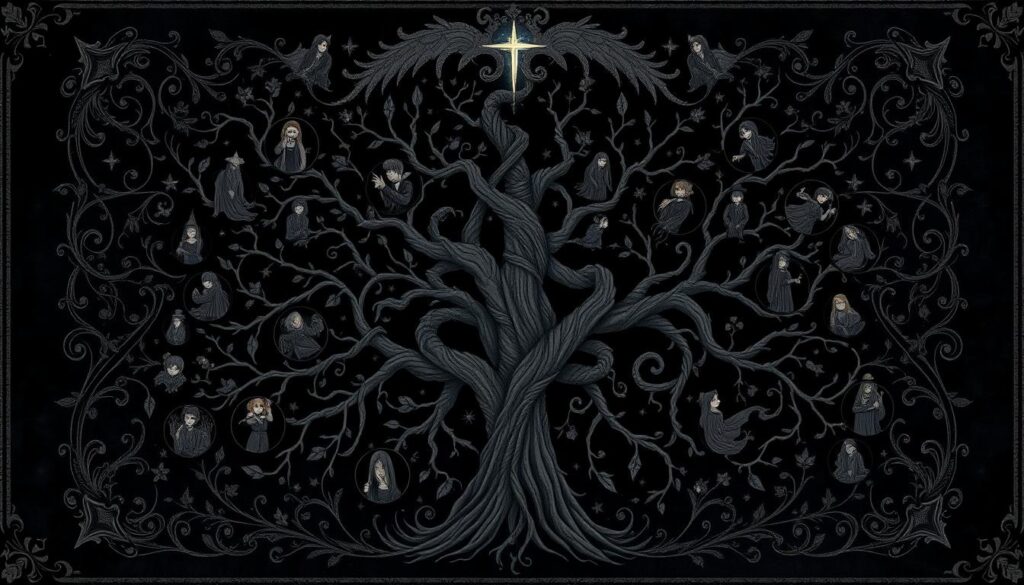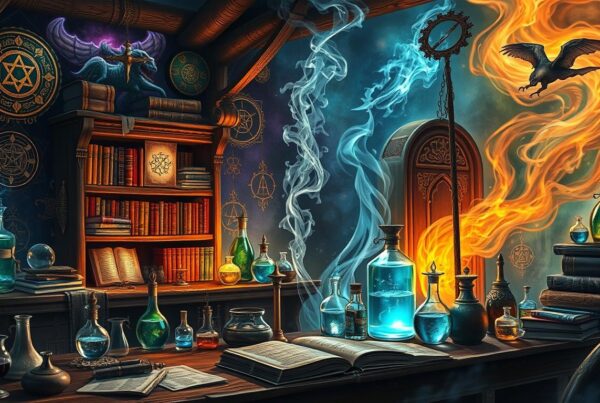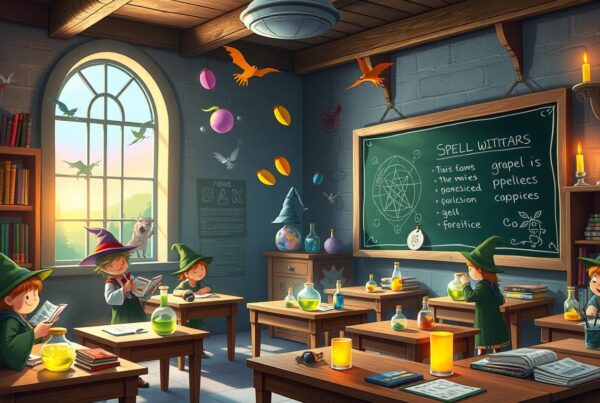The wizarding world in the Harry Potter series is a tapestry woven with the threads of family lineages and bloodlines. From the sacred twenty-eight to the families that defy the notion of pure-blood supremacy, the concept of ancestry plays a significant role in shaping the identities and destinies of witches and wizards. While some wizarding families take pride in maintaining their pure-blood status, others embrace a more inclusive approach, welcoming half-bloods and Muggle-borns into their ranks.
The lineages of these magical families are as diverse as they are fascinating. Some, like the Malfoys and the Blacks, have a long history of involvement with the dark arts, while others, such as the Weasleys and the Potters, are known for their bravery and commitment to fighting against the forces of evil. Regardless of their allegiances, each family has its own unique story, filled with triumphs, tragedies, and secrets that span generations.
Key Takeaways
- Family lineages and bloodlines play a significant role in the wizarding world
- The sacred twenty-eight are a group of pure-blood wizarding families
- Not all pure-blood families subscribe to the notion of blood supremacy
- Families like the Weasleys and the Potters embrace inclusivity and fight against the dark arts
- Each wizarding family has its own unique history and secrets
The Sacred Twenty-Eight: Pure-Blood Wizarding Families
In the wizarding world, blood purity has long been a contentious issue, with some families placing great importance on maintaining a pure-blood lineage. The concept of the Sacred Twenty-Eight, a directory of British wizarding families considered “truly pure-blood,” emerged in the 1930s, further fueling the debate surrounding blood status in wizarding society.
Definition and Significance of the Sacred Twenty-Eight
The Sacred Twenty-Eight, as documented in the Pure-Blood Directory by Cantankerus Nott, listed 28 wizarding families deemed to have the purest bloodlines. These families, including the Malfoys, Blacks, and Lestranges, often held significant influence and power due to their blood status. Being part of the Sacred Twenty-Eight was a matter of pride for many, as it symbolized their adherence to pure-blood supremacy and their perceived superiority over other wizarding families.
The importance placed on blood purity by certain families led to a clear divide in the wizarding world, with those who upheld the notion of pure-blood supremacy on one side and those who rejected such beliefs on the other. The Sacred Twenty-Eight served as a tangible representation of this divide, highlighting the deeply ingrained prejudices and biases that existed within wizarding society.
Controversial Nature of the Pure-Blood Directory
Despite the prestige associated with being part of the Sacred Twenty-Eight, not all families included in the directory embraced their status. The Weasley family, for example, openly spoke out against the list and declared that they were not ashamed of having Muggle ancestry. This stance earned them the label of “blood traitors” from those who took pride in their pure-blood lineage.
The controversial nature of the Pure-Blood Directory extended beyond the inclusion or exclusion of specific families. The very notion of categorizing wizarding families based on their blood status was seen by many as a form of discrimination and prejudice. Critics argued that a person’s worth and magical abilities were not determined by their ancestry, and that the emphasis on blood purity only served to perpetuate harmful stereotypes and divisions within the wizarding community.
| Family Name | Notable Members | Stance on Blood Purity |
|---|---|---|
| Malfoy | Lucius, Narcissa, Draco | Strong proponents of pure-blood supremacy |
| Black | Sirius, Bellatrix, Regulus | Mostly adhered to pure-blood beliefs, with some exceptions |
| Weasley | Arthur, Molly, Bill, Charlie, Percy, Fred, George, Ron, Ginny | Rejected the notion of blood purity and embraced Muggle ancestry |
| Lestrange | Rodolphus, Rabastan, Bellatrix (by marriage) | Fervent supporters of pure-blood ideals and Voldemort’s cause |
As the wizarding world evolved, the significance of the Sacred Twenty-Eight and the Pure-Blood Directory diminished. The rise of half-blood and Muggle-born witches and wizards, who proved to be just as capable and talented as their pure-blood counterparts, challenged the long-held beliefs about blood purity. Nonetheless, the legacy of the Sacred Twenty-Eight remains a testament to the complex history of blood status in the wizarding world and its lasting impact on wizarding society.
Notable Members of the Sacred Twenty-Eight Families
Among the Sacred Twenty-Eight, several families have produced notable members who have significantly influenced the wizarding world, whether through their allegiance to dark magic or their unwavering support for Muggle rights. Let’s take a closer look at some of these families and their most prominent members.
The Malfoys: Influence and Ties to Dark Magic
The Malfoy family, one of the wealthiest and most influential of the Sacred Twenty-Eight, has a long history of ties to dark magic. Lucius Malfoy, the patriarch of the family during the First and Second Wizarding Wars, was a prominent Death Eater and close ally of Lord Voldemort. His son, Draco Malfoy, followed in his father’s footsteps, joining the Death Eaters as a teenager and playing a crucial role in the infiltration of Hogwarts during the Second Wizarding War.
“The Malfoys have always been known for their wealth, influence, and pureblood supremacy. It’s no surprise that they were among Voldemort’s most loyal followers.”
The Weasleys: Blood Traitors and Muggle Supporters
In stark contrast to the Malfoys, the Weasley family, despite being part of the Sacred Twenty-Eight, has been labeled as “blood traitors” due to their acceptance and support of Muggles and Muggle-borns. Arthur Weasley, the head of the family, works in the Misuse of Muggle Artifacts Office at the Ministry of Magic and is known for his fascination with Muggle technology. The Weasleys’ open-mindedness and willingness to embrace Muggle culture have made them targets of ridicule and disdain among pure-blood supremacists.
The Lestranges: Loyal Death Eaters
The Lestrange family, another member of the Sacred Twenty-Eight, is infamous for its unwavering loyalty to Lord Voldemort and the Death Eaters. Bellatrix Lestrange, arguably the most notorious member of the family, was one of Voldemort’s most devoted and ruthless followers. Along with her husband, Rodolphus Lestrange, and brother-in-law, Rabastan Lestrange, Bellatrix participated in numerous atrocities during the First and Second Wizarding Wars, including the torture of Frank and Alice Longbottom.
| Family | Notable Members | Allegiance |
|---|---|---|
| Malfoy | Lucius Malfoy, Draco Malfoy | Death Eaters |
| Weasley | Arthur Weasley | Muggle Supporters |
| Lestrange | Bellatrix Lestrange, Rodolphus Lestrange | Death Eaters |
These three families, all part of the Sacred Twenty-Eight, demonstrate the diverse range of ideologies and allegiances within the wizarding world’s pure-blood elite. While some, like the Malfoys and Lestranges, cling to their pure-blood status and embrace dark magic, others, like the Weasleys, reject these notions and strive for a more inclusive and accepting society.
The Black Family: A Legacy of Dark Wizards
The House of Black, one of the largest, oldest, and wealthiest pure-blooded wizarding families in Great Britain, has a complex history intertwined with the dark arts. As part of the Sacred Twenty-Eight, the Blacks were known for their unwavering commitment to blood purity, as reflected in their family motto, “Toujours Pur,” which translates to “Always Pure” in French.

The Black family tree, displayed in the ancestral home at 12 Grimmauld Place, showcases the intricate lineage of this prominent wizarding family. The tree features burn marks where disowned members, such as Sirius Black, were removed for not adhering to the family’s pure-blood ideals.
The Black Family Tree and Its Branches
The Black family tree is extensive, with numerous branches and connections to other notable pure-blood families, such as the Malfoys, Lestranges, Potters, Weasleys, and Longbottoms. While the male line of the House of Black became extinct with the deaths of Sirius and Regulus Black, the female line continued through descendants of the Malfoy, Potter, and Weasley families, as well as characters like Teddy Lupin and Delphini.
| Family Member | Relationship | Notable Facts |
|---|---|---|
| Sirius Black | Son of Orion and Walburga Black | Disowned for opposing pure-blood ideals, member of the Order of the Phoenix |
| Bellatrix Lestrange | Daughter of Cygnus and Druella Black | Loyal Death Eater, known for her cruelty and mastery of the Cruciatus Curse |
| Andromeda Tonks | Daughter of Cygnus and Druella Black | Disowned for marrying a Muggle-born, mother of Nymphadora Tonks |
| Narcissa Malfoy | Daughter of Cygnus and Druella Black | Wife of Lucius Malfoy, mother of Draco Malfoy |
| Regulus Black | Son of Orion and Walburga Black | Former Death Eater, sacrificed his life to help destroy one of Voldemort’s Horcruxes |
Sirius Black: The White Sheep of the Family
Sirius Black, the heir to the Black family, stood out as a notable exception to the family’s dark legacy. Sorted into Gryffindor and later disowned for rejecting the family’s pure-blood supremacist views, Sirius became a member of the Order of the Phoenix and fought against Lord Voldemort. His loyalty to his friends, particularly James Potter, set him apart from the rest of the Black family.
“I hated the lot of them: my parents with their pure-blood mania, convinced that to be a Black made you practically royal… my idiot brother, soft enough to believe them…” – Sirius Black
Bellatrix Lestrange: Voldemort’s Most Devoted Follower
Bellatrix Lestrange, born Bellatrix Black, was one of the most infamous members of the Black family. As a loyal Death Eater, she was known for her cruelty and her mastery of the Cruciatus Curse. Bellatrix’s devotion to Lord Voldemort was unmatched, and she spent years in Azkaban prison for her crimes, including torturing Frank and Alice Longbottom and killing Sirius Black, making her one of the most feared witches in the wizarding world.
- Bellatrix was a member of the Sacred Twenty-Eight pure-blood families
- She was a skilled duellist and a master of the Dark Arts
- Bellatrix was one of Voldemort’s most trusted and loyal followers
- She was responsible for the torture of Neville Longbottom’s parents and the death of Sirius Black
The Potter Family: A History of Bravery and Sacrifice
The Potter family, while not included in the Sacred Twenty-Eight, has a long and distinguished history in the wizarding world. For centuries, the Potters were considered a pureblood family, but their egalitarian stance on blood purity led to their exclusion from the exclusive directory. Despite this, the Potter family has consistently demonstrated bravery, loyalty, and a willingness to sacrifice for the greater good.
James Potter, born on March 27, 1960, was a proud Gryffindor who embodied the house’s traits of courage and chivalry. As a member of the Marauders alongside his best friends Sirius Black, Remus Lupin, and Peter Pettigrew, James became an unregistered Animagus, transforming into a stag to accompany Lupin during his werewolf transformations. James’s Patronus also took the form of a stag, earning him the nickname “Prongs.”
Despite his privileged upbringing as the only child of the wealthy Fleamont and Euphemia Potter, James grew to become a compassionate and brave individual. He fell in love with Lily Evans, a Muggle-born witch, and together they defied Lord Voldemort three times. As members of the Order of the Phoenix, James and Lily fought against the dark forces during the First Wizarding War.
“The last enemy that shall be destroyed is death.” – James and Lily Potter’s tombstone in Godric’s Hollow
On October 31, 1981, James and Lily Potter made the ultimate sacrifice to protect their son, Harry, from Lord Voldemort. James, wandless and ready to lay down his life, tried to hold off the Dark Lord to give his wife and child time to escape. Lily, refusing to step aside, shielded her son with her love, providing Harry with powerful magical protection that would shape his destiny.
| Potter Family Member | Notable Contribution |
|---|---|
| Henry Potter | Served on the Wizengamot from 1913-1921, advocating for Muggles during World War I |
| Fleamont Potter | Invented Sleekeazy’s Hair Potion, quadrupling the family’s wealth |
| James Potter | Member of the Order of the Phoenix, sacrificed his life to protect his family |
| Lily Potter | Sacrificed her life to save her son, providing him with powerful magical protection |
| Harry Potter | The Boy Who Lived, defeated Lord Voldemort and brought an end to the Second Wizarding War |
Harry Potter, born on July 31, 1980, inherited the bravery and selflessness of his parents. As the Boy Who Lived, Harry faced numerous challenges and battles throughout his life, ultimately defeating Lord Voldemort and bringing an end to the Second Wizarding War. Harry’s love for his friends and family, as well as his unwavering courage in the face of adversity, solidified his place as a true hero in the wizarding world.
The Potter family’s legacy continues through Harry’s children, James Sirius, Albus Severus, and Lily Luna, ensuring that the values of bravery, love, and sacrifice will endure for generations to come.
The Gaunt Family: Descendants of Salazar Slytherin
The Gaunt family, once a proud and influential pure-blood wizarding family, traced their lineage directly back to Salazar Slytherin, one of the four founders of Hogwarts School of Witchcraft and Wizardry. The Gaunts were known for their ability to speak Parseltongue, a rare and often feared skill passed down through generations of Slytherin’s descendants.
The Gaunt Family’s Fall from Grace
Despite their illustrious ancestry, the Gaunt family’s fortunes took a turn for the worse over the centuries. Their obsession with maintaining blood purity led them to practice endogamy, marrying within their own family to preserve their pure-blood status. This practice, coupled with their extravagant spending habits, eventually led to the family’s decline into poverty.
By the early 20th century, the Gaunts were living in a small, run-down shack, clinging to their few remaining family heirlooms and their pride in their pure-blood heritage. Marvolo Gaunt, the family patriarch, was a harsh and abusive man who took great pride in his ancestry and looked down upon those he considered beneath him, particularly Muggles and Muggle-borns.
Merope Gaunt and Tom Riddle Sr.: A Tragic Love Story
Merope Gaunt, Marvolo’s daughter, lived a life of misery and neglect under her father’s tyrannical rule. Despite this, she fell deeply in love with Tom Riddle Sr., a handsome and wealthy Muggle who lived nearby. Desperate to win his affection, Merope secretly gave Tom a love potion, which led to their marriage and the birth of their son, Tom Marvolo Riddle.
However, Merope’s happiness was short-lived. She eventually stopped giving Tom the love potion, believing that he would stay with her of his own accord. Tragically, Tom abandoned his wife and unborn child, leaving Merope heartbroken and destitute. She later died in childbirth, leaving young Tom to grow up in a Muggle orphanage, unaware of his magical heritage.
The Birth of Lord Voldemort: The Last Gaunt Heir
Tom Marvolo Riddle, the son of Merope Gaunt and Tom Riddle Sr., grew up to become one of the most feared dark wizards in history, Lord Voldemort. Upon discovering his connection to Salazar Slytherin and the Gaunt family, Tom embraced his role as the Heir of Slytherin and began his quest for power and immortality.
Voldemort’s rise to power was marked by his creation of horcruxes, dark magical objects that allowed him to split his soul and achieve a form of immortality. His reign of terror lasted for decades, as he sought to rid the wizarding world of those he considered unworthy, particularly Muggle-borns and half-bloods.
| Gaunt Family Member | Significance |
|---|---|
| Marvolo Gaunt | Patriarch of the Gaunt family in the early 20th century, known for his pride in his pure-blood heritage and his harsh treatment of his children. |
| Merope Gaunt | Marvolo’s daughter, who fell in love with Tom Riddle Sr. and gave birth to Tom Marvolo Riddle, later known as Lord Voldemort. |
| Morfin Gaunt | Marvolo’s son and Merope’s brother, known for his violent behavior and ability to speak Parseltongue. |
| Tom Marvolo Riddle | The son of Merope Gaunt and Tom Riddle Sr., who grew up to become Lord Voldemort, one of the most feared dark wizards in history. |
The tragic story of the Gaunt family serves as a cautionary tale, highlighting the dangers of obsession with blood purity and the consequences of unchecked ambition. Through their descendant, Lord Voldemort, the Gaunts left a lasting impact on the wizarding world, one that would take years to overcome.
The Longbottom Family: Courage in the Face of Adversity
The Longbottom family, though not part of the Sacred Twenty-Eight, has a rich history of bravery and resilience in the wizarding world. Their unwavering commitment to fighting against the dark forces has earned them a place among the most respected families in the magical community.

Frank and Alice Longbottom: Tortured by Death Eaters
Frank and Alice Longbottom were highly skilled Aurors and devoted members of the Order of the Phoenix during the First Wizarding War. Their exceptional talents and unwavering loyalty to the cause made them formidable opponents to Lord Voldemort and his followers. However, their bravery came at a great cost.
After the fall of Voldemort, a group of Death Eaters, led by the infamous Bellatrix Lestrange, captured and tortured the Longbottoms using the Cruciatus Curse. The prolonged exposure to this unforgivable curse left Frank and Alice permanently incapacitated, unable to recognize even their own son, Neville. Despite their tragic fate, their sacrifice serves as a testament to their courage and dedication to fighting against the dark forces that threatened the wizarding world.
Neville Longbottom: From Underdog to Hero
Neville Longbottom, the son of Frank and Alice, grew up under the care of his grandmother, Augusta Longbottom. In his early years at Hogwarts, Neville was often seen as a shy and clumsy student, struggling to find his place among his peers. However, as he faced numerous challenges and obstacles, Neville began to discover his inner strength and courage.
Joining Dumbledore’s Army, a secret organization founded by Harry Potter to teach defensive magic, proved to be a turning point for Neville. Through his participation in the group, he honed his skills and gained confidence in his abilities. Neville’s bravery and determination shone through during the Battle of Hogwarts, where he played a crucial role in the fight against Voldemort and his Death Eaters.
| Character | Contribution | Impact |
|---|---|---|
| Frank and Alice Longbottom | Fought against Death Eaters as Aurors and Order of the Phoenix members | Inspired others with their bravery and sacrifice |
| Neville Longbottom | Destroyed Nagini, Voldemort’s final Horcrux, using the Sword of Gryffindor | Made Voldemort mortal, contributing to his ultimate defeat |
In a moment of true heroism, Neville wielded the Sword of Gryffindor and slayed Nagini, Voldemort’s final Horcrux. This act of bravery not only showcased Neville’s growth as a wizard but also played a vital role in making Voldemort mortal once more, paving the way for his eventual defeat.
“I’ll join you when hell freezes over,” said Neville. “Dumbledore’s Army!” he shouted, and there was an answering cheer from the crowd, whom Voldemort’s Silencing Charms seemed unable to hold.
The Longbottom family’s legacy of courage and resilience serves as an inspiration to the entire wizarding world. Their unwavering commitment to fighting against the dark forces, even in the face of unimaginable adversity, has solidified their place in the annals of magical history.
The Lovegood Family: Eccentric and Unorthodox
The Lovegood family, consisting of Xenophilius Lovegood and his daughter Luna Lovegood, is known for their unconventional beliefs and quirky approach to life in the wizarding world. Xenophilius, the editor of the eccentric magazine The Quibbler, is a firm believer in various conspiracy theories and unusual creatures, which often puts him at odds with mainstream wizarding society.
Luna, a student in the Ravenclaw house at Hogwarts School of Witchcraft and Wizardry, is often ridiculed by her peers for her peculiar ideas and beliefs. Despite this, she remains true to herself and proves to be a valuable friend and ally to Harry Potter and his friends, particularly during the Second Wizarding War.
“The Quibbler is going for a new angle, then?” Harry asked, trying to sound casual.
“Oh yes, it’s a great chance to educate people, brilliant opportunity…”
– Xenophilius Lovegood, Harry Potter and the Deathly Hallows
Some notable facts about the Lovegood family include:
- Xenophilius Lovegood’s unwavering support for Harry Potter during the Second Wizarding War, using The Quibbler to spread the truth about Voldemort’s return.
- Luna Lovegood’s membership in Dumbledore’s Army, a secret organization formed to practice defensive magic and resist the oppressive rule of Dolores Umbridge at Hogwarts.
- The Lovegood family’s attendance at the 1994 Quidditch World Cup, showcasing their involvement in the wizarding community despite their eccentricities.
| Family Member | Notable Characteristic |
|---|---|
| Xenophilius Lovegood | Editor of The Quibbler, believes in conspiracy theories |
| Luna Lovegood | Ravenclaw student, member of Dumbledore’s Army |
| Pandora Lovegood | Luna’s mother, died in a magical experiment accident |
Although often misunderstood and marginalized, the Lovegood family’s unwavering commitment to their beliefs and their support for the fight against dark forces make them an integral part of the Harry Potter universe. Their eccentricity and unorthodox approach to life add a unique flavor to the wizarding world, reminding readers that being different is not a weakness, but a strength.
Bloodlines and the Wizarding World: The Importance of Family Ties
In the wizarding world, family ties and bloodlines play a crucial role in shaping a wizard’s identity, social standing, and influence. Many witches and wizards are heavily influenced by their family’s beliefs, values, and allegiances, which can have a significant impact on their lives and the choices they make. Wizarding families like the Weasleys, Blacks, Lestranges, Malfoys, and Scamanders have left an indelible mark on the magical community, with their members often playing key roles in shaping the course of wizarding history.
The Role of Family in Shaping a Wizard’s Identity
A wizard’s family background can have a profound effect on their identity and the path they choose to follow in life. For example, the Black family, an ancient and pure-blooded wizarding family, has a long history of upholding traditional values and supporting dark magic. However, some members, like Sirius Black and Andromeda Tonks, chose to break away from their family’s pure-blood supremacist views and forge their own paths, demonstrating that while family history is important, it does not necessarily define a person’s destiny.
“I’m not proud of my family. I’m not proud of the things my family has done. But I’m proud of who I am and what I’ve become, and I’m proud of the choices I’ve made.” – Sirius Black
The Impact of Blood Status on Social Standing
Blood status is another significant factor that determines a wizard’s social standing in the magical world. Pure-blood families, especially those included in the Sacred Twenty-Eight, often hold positions of power and influence, while half-bloods and muggle-borns face varying degrees of discrimination and prejudice from those who believe in pure-blood supremacy.
| Blood Status | Definition | Examples |
|---|---|---|
| Pure-blood | Wizards with no known Muggle or Muggle-born ancestors | Malfoys, Blacks, Lestranges |
| Half-blood | Wizards with at least one Muggle or Muggle-born parent or grandparent | Harry Potter, Severus Snape |
| Muggle-born | Wizards born to two non-magical parents | Hermione Granger, Lily Potter |
This discrimination is evident in the actions of characters like Draco Malfoy and the Death Eaters, who seek to subjugate and eliminate Muggle-borns from the wizarding world. However, many wizarding families, such as the Weasleys, reject these prejudices and champion equality and acceptance, regardless of blood status.
- The Weasley family, despite being pure-bloods, are known for their acceptance and support of Muggle-borns and half-bloods.
- The Black family, traditionally associated with pure-blood supremacy, produced several members who rejected these beliefs, like Sirius Black and Andromeda Tonks.
- The Malfoy family, while influential and wealthy, faced criticism and ostracism for their involvement with Death Eaters and support of Lord Voldemort.
In conclusion, family ties and blood status play a significant role in shaping the identities, social standing, and experiences of witches and wizards in the magical world. While some families perpetuate prejudice and discrimination based on blood purity, others, like the Weasleys and certain members of the Black family, demonstrate that one’s family background does not necessarily determine their beliefs or actions, and that acceptance and equality can triumph over bigotry and hatred.
Conclusion
Throughout the Harry Potter series, the intricate tapestry of wizarding world families and their ties to blood purity and magical lineage is woven into the very fabric of the story. From the prestigious pure-blood families like the Malfoys and the Blacks to the more inclusive and accepting attitudes of the Weasleys and the Potters, the series delves deep into the impact of family ties and blood status on individual characters and the wider wizarding society.
Magical ability, as demonstrated through various studies and observations in the Harry Potter universe, shows strong evidence of heritability. Specific magical skills, such as the ability to speak to snakes (Parseltongue), predict the future (clairvoyance), and change one’s physical appearance (Metamorphmagus), appear to be conferred by specific genes. The presence of magical abilities in offspring resulting from matings between magical folk and between magical individuals and Muggles suggests a dominant gene at play, with a multilocus model and epistatic interactions likely involved.
Beyond the genetic aspects, family ties and blood purity also shape social hierarchies and inter-clan alliances within the wizarding world. The Sorting Hat Ceremony at Hogwarts, which determines house affiliations based on a student’s values and characteristics, further reinforces these divisions and the importance of lineage. However, through the stories of these diverse families, readers learn valuable lessons about the power of love, courage, and acceptance in the face of adversity and prejudice. Ultimately, the Harry Potter series demonstrates that while family history and bloodlines may influence a person’s identity, it is their choices and actions that truly define them.



